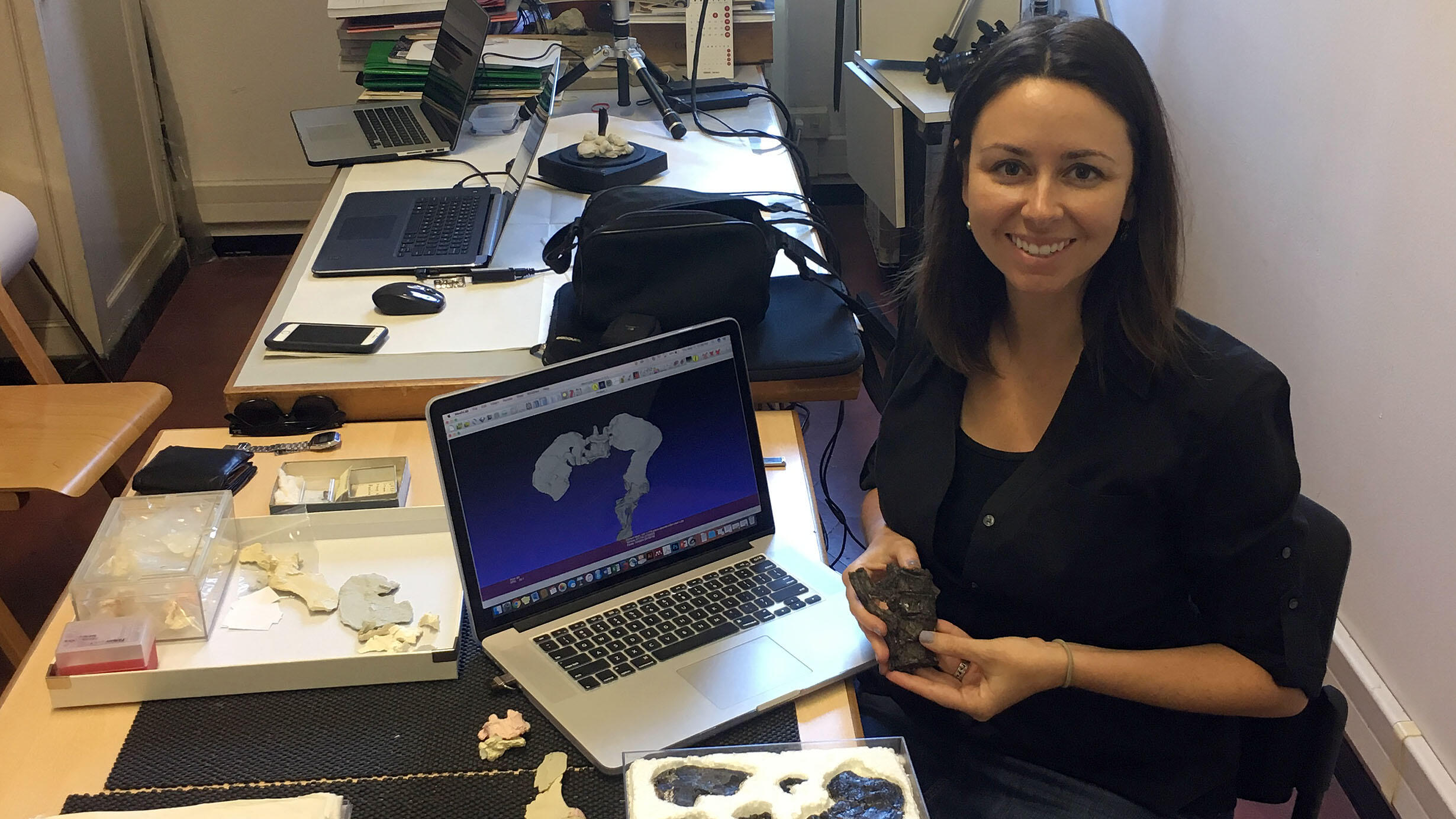Ancient Ape Was a Climber, Not a Walker
 Ashley Hammond, an assistant curator in the Museum’s Division of Anthropology and lead author of the study, investigated the newly prepared Oreopithecus bambolii skeleton at the Natural History Museum of the University of Florence.
Ashley Hammond, an assistant curator in the Museum’s Division of Anthropology and lead author of the study, investigated the newly prepared Oreopithecus bambolii skeleton at the Natural History Museum of the University of Florence.A. Hammond/© AMNH
Some have said it walked upright on two legs. Others suggest it moved under branches like a sloth. The locomotion of Oreopithecus bambolii, an ape that lived between 6 and 8 million years ago, is nothing short of contentious. New work published today in the Proceedings of the National Academy of Sciences continues the debate, showing that the extinct primate likely was a climber, but that it moved differently from all living species of apes.
“If you can name a locomotor behavior that’s been attributed to a primate, it probably has been applied to this fossil,” said lead author Ashley Hammond, an assistant curator in the American Museum of Natural History’s Division of Anthropology.
More than 60 years ago, researchers found a surprisingly complete fossilized skeleton of Oreopithecus embedded in a slab of coal in a part of Italy that used to be an island. Oreopithecus is an ape but it does not belong to the same lineage as humans. Since its discovery, its anatomy has confounded scientists, primarily because the skeleton was flattened during fossilization.
© S. Bambi, Sistema Museale dell'Università di Firenze
“It’s fairly complete, but it’s flat as a pancake,” Hammond said. “I can understand why it has led to such drastically different conclusions. It doesn’t look exactly like a living ape and it doesn’t look like a human. But you can start to imagine all the different ways it might have looked because the fossil has been so distorted and deformed.”
Adding to the enigmatic nature of this fossil are its strange teeth, Hammond said. Their unusual shape make it difficult to determine how Oreopithecus was specifically related to other species, what it ate, and how it behaved. In the new study, Hammond worked with Museum senior research scientist Sergio Almécija and collaborators to take a comprehensive look at all of the vertebrae and pelvic fossil material for Oreopithecus, including the Italian specimen—housed at the Natural History Museum of the University of Florence—and pieces found from other Oreopithecus individuals that are part of the collections at the Natural History Museum of Basel, Switzerland.
The Italian skeleton was prepared over the course of several years with a focus on the pelvic elements, and Hammond and Almécija were among the first outside researchers to access it since that work took place. The researchers compared the ape’s features to bipedal hallmarks in early hominins.
A. Hammond/© AMNH
“We were able to get a glimpse of anatomy that couldn’t be appreciated before the new preparation of the fossil,” Almécija said. “What we see is a combination of features that is new to science, providing a much needed view of how this late Miocene ape looked. We can confirm it was a good climber, not a habitual suspensory ape or a biped.”
The researchers found that the body form of Oreopithecus isn’t seen in living apes: it had a more flexible lumbar region than living great apes, giving it greater behavioral diversity. With limb proportions intermediate between modern-day orangutans and bonobos, it would have been a skilled climber. But its shorter fingers probably made it less suited for hanging below the branches. Its torso shape was similar to siamangs (the largest of the “lesser apes” that also includes gibbons). However, in terms of overall body size, Oreopithecus was bigger than the “lesser apes,” and would have been on the lower end of the size range of great apes alive today.
“Oreopithecus might give us an idea of what it means to be an ape at this particular body size,” Hammond said. “It’s also important to consider fossil apes in the context of 3 early hominins because it gives us a guidepost as to where early hominins started off. Oreopithecus is not an ancestor of hominins, but it gives us a window to what was happening in that time period.”
Other researchers on this study include Lorenzo Rook, from the University of Florence; Alisha Anaya, from the American Museum of Natural History; Elisabetta Cioppi, from the Natural History Museum of the University of Florence; Loïc Costeur, from the Natural History Museum of Basel; and Salvador Moyà-Solà, from the Institut Català de Paleontologia Miquel Crusafont and the Catalan Institution for Research and Advanced Studies. This work was funded, in part, by the Wenner-Gren Foundation, Leakey Foundation, the Research Centers of Catalonia (CERCA), Spanish AEI/FEDER EU, and MINECO.